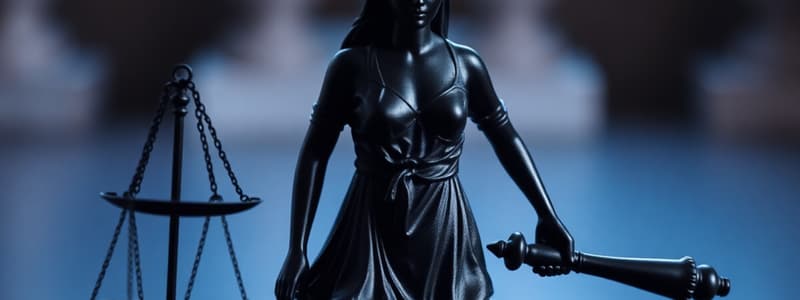Podcast
Questions and Answers
Which concept emphasizes addressing the underlying causes of harm and injustice through systemic change?
Which concept emphasizes addressing the underlying causes of harm and injustice through systemic change?
- Restorative Justice
- Retributive Justice
- Distributive Justice
- Transformative Justice (correct)
Which theory posits that crime is more likely in areas characterized by deteriorated social structures?
Which theory posits that crime is more likely in areas characterized by deteriorated social structures?
- Social Justice
- Strain Theory
- Disorganization Theory (correct)
- Economic Theory of Crime
What does 'Crimmigration' refer to in the context of legal and justice systems?
What does 'Crimmigration' refer to in the context of legal and justice systems?
- The application of criminal justice practices to immigration enforcement. (correct)
- The study of crime statistics across different immigrant communities.
- The process of deporting criminals to their country of origin.
- The legal representation provided to immigrants accused of crimes.
Which of the following is most closely associated with promoting entrepreneurship and deregulation for economic growth?
Which of the following is most closely associated with promoting entrepreneurship and deregulation for economic growth?
An economic downturn leads to increased property crime as people struggle to meet their basic needs. Which theory best explains this phenomenon?
An economic downturn leads to increased property crime as people struggle to meet their basic needs. Which theory best explains this phenomenon?
Which concept is best exemplified by ensuring that all students, regardless of socioeconomic status, have access to quality education?
Which concept is best exemplified by ensuring that all students, regardless of socioeconomic status, have access to quality education?
A company decides to move its factory overseas to reduce labor costs, leading to job losses in its home country. How would the Economic Theory of Crime potentially explain a rise in crime following this decision?
A company decides to move its factory overseas to reduce labor costs, leading to job losses in its home country. How would the Economic Theory of Crime potentially explain a rise in crime following this decision?
A community implements a program where offenders meet with their victims to discuss the harm caused and agree on ways to repair it. Which approach to justice does this exemplify?
A community implements a program where offenders meet with their victims to discuss the harm caused and agree on ways to repair it. Which approach to justice does this exemplify?
Which concept describes the industries and systems that profit from death and suffering, such as private prisons and certain aspects of healthcare?
Which concept describes the industries and systems that profit from death and suffering, such as private prisons and certain aspects of healthcare?
A country's GDP increases significantly, but the income inequality also widens, with the rich getting richer and the poor remaining stagnant. What concept does this illustrate?
A country's GDP increases significantly, but the income inequality also widens, with the rich getting richer and the poor remaining stagnant. What concept does this illustrate?
Flashcards
Social Justice
Social Justice
Promoting fair treatment regardless of one's background, identity, or circumstances; addresses systemic inequalities.
Restorative Justice
Restorative Justice
Justice that focuses on repairing harm between the offender and the victim.
Sanctions
Sanctions
Penalty or corrective measure imposed to enforce rules, laws, or standards to deter undesirable behavior.
Retributive Justice
Retributive Justice
Signup and view all the flashcards
Transformative Justice
Transformative Justice
Signup and view all the flashcards
Distributive Justice
Distributive Justice
Signup and view all the flashcards
Economic Theory of Crime
Economic Theory of Crime
Signup and view all the flashcards
Strain Theory
Strain Theory
Signup and view all the flashcards
Capitalism
Capitalism
Signup and view all the flashcards
Neoliberalism
Neoliberalism
Signup and view all the flashcards
Study Notes
Definitions
- Social Justice promotes fair treatment regardless of background, identity, or circumstance, and addresses systemic inequalities.
- Restorative Justice focuses on repairing harm between the offender and victim.
- Sanctions are penalties or corrective measures imposed to enforce rules, laws, or standards to deter undesirable behavior.
- Retributive Justice focuses on punishment for wrongdoers.
- Transformative Justice seeks to address the root causes of harm and injustice by focusing on community and systemic change rather than punishment.
- Distributive Justice ensures the fair distribution of resources in society, so individuals receive what they are due.
- Economic Theory of Crime suggests individuals make cost-benefit analyses before committing crimes.
- Strain Theory (MERTON) states crime occurs when people are at a societal disadvantage, lacking the means to achieve their goals.
- Disorganization Theory asserts crime is more likely in communities with weak social bonds and instability.
- Crimmigration is the intersection of criminal and immigration law, aligning immigration enforcement policies with criminal justice practices instead of civil immigration penalties.
- Legal Consciousness refers to how individuals perceive, understand, or interpret the law and their relationship to it.
- Economy of Death refers to industries and systems that profit from death and suffering, such as private prisons and healthcare.
- Gross Domestic Product (GDP) is the market value of all goods and services produced within a country over a specific timeframe.
- Wealth Gap is the disparity in the distribution of wealth among individuals within a society.
- Income Inequality is the uneven distribution of income or wages within a population, where some individuals earn significantly more than others.
- Preschool to Prison Pipeline indicates harsh disciplinary practices in minority and disadvantaged children which increase the likelihood of future involvement in the criminal justice system.
- Human Trafficking involves the illegal trade of humans for exploitation, including forced labor or sexual slavery.
- Capitalism is an economic system where private businesses or individuals control the production and distribution of goods and services.
- Marxism is a socio-economic theory arguing that society is divided into classes based on economic power, and capitalism leads to inequality and exploitation.
- Neoliberalism promotes entrepreneurship and believes that reducing the role of the state leads to greater economic growth and efficiency.
Historical Timeline
- GI Bill (1944)
- Civil Rights (1950's)
- Black Power Movement (Mid 1960's)
- American Indian Movement (1968)
- AAPI Movement (late 1960's)
- War on Drugs (1971-80's)
- For profit prison systems (1980's)
- Black Lives Matter Movement (2010-2020)
- Civil Unrest in COVID (2020)
Studying That Suits You
Use AI to generate personalized quizzes and flashcards to suit your learning preferences.




